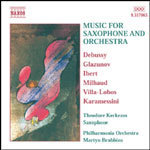
Works for Saxophone and Orchestra
 $25.00
Out of Stock
$25.00
Out of Stock6+ weeks add to cart
KARAMESSINI / DEBUSSY / GLAZUNOV / VILLA-LOBOS / IBERT / MILHAUD
Works for Saxophone and Orchestra
Theodore Kerkezos, saxophone Philharmonia Orchestra, London Martyn Brabbins, conductor
[ Naxos / CD ]
Release Date: Sunday 15 December 2002
This item is currently out of stock. It may take 6 or more weeks to obtain from when you place your order as this is a specialist product.
Debussy completed his Rapsodie for orchestra and alto saxophone in 1908, in response to an earlier commission from the American saxophonist Mrs Elise Hall, suggesting the possible future direction his music might have taken. The scoring was only carried out in 1919, after Debussy's death, by Roger-Ducasse. Listening to street-hawkers crying their wares, Debussy managed to adjust these simple sounds to his extraordinary work for orchestra and saxophone. As indicated in the title, the saxophone here shares its leading part with the orchestra. The work is in two parts. In the first part the dark sound of the saxophone, along with the woodwind, presents the themes that will follow. In the second part the change of style in the orchestra suggests Liszt's Hungarian Rhapsodies.The version recorded here is the original with two additional bars.
Scaramouche is one of the many theatrical characters of the commedia dell'arte. Milhaud's Scaramouche is taken from incidental music for a play based on Molière's Le médecin volant (The Flying Doctor) staged at the Théâtre Scaramouche in Paris in May 1937. Originally composed for saxophone and orchestra, the music was, two years later, successfully arranged by the composer for two pianos. Scaramouche is filled with Latin American rhythmic and melodic contrasts. After a vivid and festive Vif there follows a charming Modéré slow movement without sentimental exaggeration. It is completed with a Samba-Brazileira, in which the orchestra and the saxophone dance in a Rio Carnival.
Jacques Ibert wrote his Concertino da camera for alto saxophone and eleven instruments in 1935 for Sigurd Rascher. The work recalls the same composer's Flute Concerto of 1934 and the influence of Ravel. The first movement, written before the other two, is influenced by jazz, witnessed by its use of syncopation. By way of contrast, the second movement is calm, quiet and simple, proceeding without a break to the brilliant finale, with its calls for virtuosity and jazz rhythms. The work is generally neo-classical in style, without romantic elements. The high notes used were requested by Rascher, despite the disapproval of the doyen of Paris saxophonist, Marcel Mule.
Heitor Villa-Lobos wrote his Fantasia for soprano saxophone, three horns and strings, Op.630, in 1948 in Rio, and dedicated it to Marcel Mule. The first movement, Animé, begins with a multi-rhythmic introduction, followed by a delicate tango. The viola plays the expressive introduction of the second movement, and the saxophone enters with a nocturne, leading mysteriously to the third movement in 7/4 metre, where the solo saxophone plays the theme played three times by the strings. Brilliant passages for the soloist lead to a robust 4/4, before the 7/4 virtuosic finale.
Glazunov wrote his Saxophone Concerto in 1934 at the request of Sigurd Rascher. It was composed two years before his death, after he had settled in France. The form of the concerto is very concise and is in a single movement. The work is not virtuosic and care has to be paid to the metronome markings. There are resemblances here with his Violin Concerto and Schumann's Cello Concerto. The saxophone continues the theme, first introduced by the strings. After the complicated development of the theme, there is a cadenza, extended at Rascher's instigation. There soon follows the theme of a fugue played by the soloist, followed by the strings. With masterly orchestration, Russian melodies lead to a grand finale.
Ekaterini Karamessini holds a doctorate and a master's degree in Composition from the University of Sussex and a bachelor's degree, summa cum laude, from Berklee College of Music in the United States, with scholarships from the Onassis Foundation and Berklee College. She won the Chanctonbury Composition Competition for the Millennium in Britain. Her music has received performances in the United States and in England, including chamber music, symphonic and choral works, ballets, songs, incidental music for the theatre, and three operas. Her Song of Dionysus is inspired by the ancient Greek myth of the god Dionysus, and the play between his original form and the Apollonian spirit. As the leading instrument of this concerto, the saxophone becomes a symbol of this transfiguration. The saxophone concerto, composed in six weeks between February and March 2002, was written for Theodore Kerkezos.
Tracks:
CLAUDE DEBUSSY
Rapsodie for orchestra and alto saxophone (original version)
01. Rapsodie for Orchestra and alto saxophone (original version) 10:06
DARIUS MILHAUD
Scaramouche for alto saxophone and orchestra
02. Vif 03:06
03. Modere 04:08
04. Brazileira 02:33
JACQUES IBERT
Concertino da camera for alto saxophone and eleven instruments
05. Allegro ma non troppo 04:28
06. Larghetto 03:18
07. Animato molto 04:16
HEITOR VILLA-LOBOS
Fantasia for soprano saxophone, three horns and strings Op.630
08. Anime 04:32
09. Lent (Vicci Wardman, Solo Viola) 03:07
10. Tres Anime 02:49
ALEXANDER KONSTANTINOVICH GLAZUNOV
Concerto in E flat major for alto saxophone and strings Op.109
11. Concerto in E flat major for alto saxophone and strings, Op.109 14:43
EKATERINI KARAMESSINI
Song of Dionysus: Concerto for saxophone and orchestra
12. Pageant and Invocation 04:22
13. Metamorphoses into Apollonian Light 05:29
14. Ritual Dance-prayer of the body-ectasis 04:10